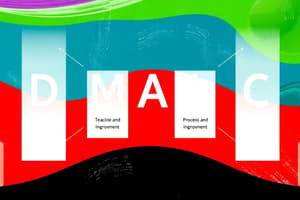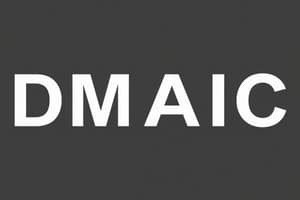Podcast
Questions and Answers
What is the primary aim of the 'Six Sigma' approach within the Lean Six Sigma methodology?
What is the primary aim of the 'Six Sigma' approach within the Lean Six Sigma methodology?
- To enhance employee satisfaction.
- To minimize defects and variations in processes. (correct)
- To accelerate the production cycle.
- To maximize resource allocation.
In the DMAIC process, which phase focuses on identifying the fundamental reasons behind issues rather than merely addressing the symptoms?
In the DMAIC process, which phase focuses on identifying the fundamental reasons behind issues rather than merely addressing the symptoms?
- Analyze (correct)
- Define
- Measure
- Improve
Why is documenting each stage of a project's progress and results vital in Lean Six Sigma?
Why is documenting each stage of a project's progress and results vital in Lean Six Sigma?
- To facilitate knowledge sharing and future reference. (correct)
- To impress stakeholders with the level of detail.
- To increase project budget allocation.
- To create additional tasks for team members.
Which principle is Taiichi Ohno primarily credited with pioneering through the Toyota Production System?
Which principle is Taiichi Ohno primarily credited with pioneering through the Toyota Production System?
What realization prompted the integration of Six Sigma and Lean methodologies into Lean Six Sigma?
What realization prompted the integration of Six Sigma and Lean methodologies into Lean Six Sigma?
What is the primary focus of Lean principles when used in conjunction with Six Sigma?
What is the primary focus of Lean principles when used in conjunction with Six Sigma?
What does the Lean Six Sigma principle of 'Focus on the Customer' primarily involve?
What does the Lean Six Sigma principle of 'Focus on the Customer' primarily involve?
What is the purpose of 'measuring the value stream' in the context of Lean Six Sigma?
What is the purpose of 'measuring the value stream' in the context of Lean Six Sigma?
Which action exemplifies the Lean Six Sigma principle of 'removing waste to create flow'?
Which action exemplifies the Lean Six Sigma principle of 'removing waste to create flow'?
In Lean Six Sigma, what is the goal of 'eliminating variations'?
In Lean Six Sigma, what is the goal of 'eliminating variations'?
How does Lean Six Sigma emphasize undertaking improvements?
How does Lean Six Sigma emphasize undertaking improvements?
Why is it crucial to equip people in processes with the necessary skills and knowledge in Lean Six Sigma?
Why is it crucial to equip people in processes with the necessary skills and knowledge in Lean Six Sigma?
What does the Lean Six Sigma principle of 'Understand the Real Work Flow' emphasize?
What does the Lean Six Sigma principle of 'Understand the Real Work Flow' emphasize?
What is the primary objective of the 'Define' phase in the DMAIC improvement cycle?
What is the primary objective of the 'Define' phase in the DMAIC improvement cycle?
What is the purpose of a 'Project Charter' within the 'Define' phase of DMAIC?
What is the purpose of a 'Project Charter' within the 'Define' phase of DMAIC?
What is the purpose of 'Voice of the Customer' (VOC) analysis in the 'Define' phase?
What is the purpose of 'Voice of the Customer' (VOC) analysis in the 'Define' phase?
During the 'Measure' phase of DMAIC, what activity is most critical?
During the 'Measure' phase of DMAIC, what activity is most critical?
In Lean Six Sigma, what is the primary role of White Belts?
In Lean Six Sigma, what is the primary role of White Belts?
Within Six Sigma projects, what responsibility is uniquely held by Black Belts?
Within Six Sigma projects, what responsibility is uniquely held by Black Belts?
How does Lean Six Sigma contribute to employee engagement and development?
How does Lean Six Sigma contribute to employee engagement and development?
Flashcards
What is Lean Six Sigma?
What is Lean Six Sigma?
A data-driven process improvement methodology combining Lean (reducing waste) and Six Sigma (minimizing defects).
What is DMAIC?
What is DMAIC?
Define, Measure, Analyze, Improve, Control; a vital process for structured problem-solving and continuous improvement.
Clear Project Definition
Clear Project Definition
The initial phase of DMAIC, focusing on defining the problem and project scope clearly.
Data Collection and Analysis
Data Collection and Analysis
Signup and view all the flashcards
Root Cause Analysis
Root Cause Analysis
Signup and view all the flashcards
Solution Testing
Solution Testing
Signup and view all the flashcards
Change Management
Change Management
Signup and view all the flashcards
Continuous Monitoring
Continuous Monitoring
Signup and view all the flashcards
Cross-Functional Teams
Cross-Functional Teams
Signup and view all the flashcards
Lean Principles
Lean Principles
Signup and view all the flashcards
Six Sigma Principles
Six Sigma Principles
Signup and view all the flashcards
Focus on the Customer
Focus on the Customer
Signup and view all the flashcards
Measure the Value Stream
Measure the Value Stream
Signup and view all the flashcards
Remove Waste to Create Flow
Remove Waste to Create Flow
Signup and view all the flashcards
Eliminate Variations
Eliminate Variations
Signup and view all the flashcards
Systematic Process Improvement
Systematic Process Improvement
Signup and view all the flashcards
Equip People in Processes
Equip People in Processes
Signup and view all the flashcards
Focus on Prevention (DFSS)
Focus on Prevention (DFSS)
Signup and view all the flashcards
House of Quality
House of Quality
Signup and view all the flashcards
What is Minitab?
What is Minitab?
Signup and view all the flashcards
Study Notes
Lean Six Sigma Overview
- Lean Six Sigma merges "Lean" for reducing waste and "Six Sigma" for minimizing defects, increasing efficiency and quality.
- Motorola adopted Lean Six Sigma early, saving over $16 billion by reducing manufacturing defects.
Six Sigma Methodology
- DMAIC (Define, Measure, Analyze, Improve, Control) is a process used for structured problem-solving.
- The DMAIC framework fosters data-driven decisions, reduces errors, and maximizes efficiency.
DMAIC Phases
- Define: Establish a clear problem statement and project scope.
- Measure: Systematically gather and ensure the accuracy of relevant data, employing statistical tools to quantify process performance.
- Analyze: Use techniques like Fishbone diagrams and the "5 Whys" to identify the root causes of issues.
- Improve: Pilot test solutions on a small scale before organization-wide implementation to minimize risks.
- Control: Implement change management strategies and continuous monitoring using KPIs to sustain improvements.
Key Elements for Implementation
- Cross-Functional Teams: Integrate team members from various departments for diverse perspectives.
- Training and Education: Provide team members with the necessary skills and tools for each DMAIC phase.
- Documenting the Process: Maintain detailed records to track progress and results, aiding knowledge sharing.
- Celebrate Success: Recognize achievements to motivate teams and promote continuous improvement.
Historical Context
- "Lean" principles trace back to the Toyota Production System (TPS) in post-WWII Japan, and Taiichi Ohno's work.
- Motorola developed Six Sigma in the 1980s, pioneered by Bill Smith, to reduce product defects by minimizing variability.
- The integration of Six Sigma and Lean into Lean Six Sigma occurred in the late 1990s and early 2000s.
Key Principles
- Lean focuses on eliminating waste and improving process flow.
- Six Sigma emphasizes reducing defects and variations.
- Together, Lean Six Sigma optimizes efficiency and quality.
- Focusing on the customer involves understanding and meeting their needs by aligning processes to deliver maximum value.
- Mapping the value stream helps identify areas of waste and inefficiency.
- Removing non-value-added activities streamlines workflow.
- Reducing process variations enhances consistency and quality.
- Using a defined methodology like DMAIC ensures systematic improvements.
- Empowering employees with skills and knowledge is critical for active participation.
- Understanding the real workflow of processes is essential for accuracy.
Six Sigma Phases breakdown
- Define Phase: Project objectives are defined, including the problem, goals, scope, resources, and team.
- Measure Phase: The current process state is assessed through data collection, process maps, and capability determination.
- Project Charter summarizes scope, goals, team, and stakeholders.
- Voice of the Customer (VOC) Analysis captures customer needs and expectations.
Analyze Phase
- Collected data undergoes in-depth analysis to identify root causes, with tools like Ishikawa diagrams and the "5 Whys".
- Popular analysis tools include Cause-and-effect Diagrams and Root Cause Analysis.
Improve Phase
- This phase focuses on resolving root causes by brainstorming ideas, redesigning processes, and testing improvements.
- Techniques used in this phase include Brainstorming and Idea Generation, Process Redesign, and Design of Experiments (DOE).
Control Phase
- This phase integrates improvements into standard processes through control charts, SOPs, and training.
- Control Charts monitor process stability.
- Standard Operating Procedures (SOPs) document standard work.
- Training and Communication Plans ensure well-implemented changes.
Lean Six Sigma Belt Levels Overview
- Lean Six Sigma uses a belt system to designate expertise and responsibilities.
- The levels are White, Yellow, Green, Black, and Master Black Belt.
Lean Six Sigma Belt Responsibilities
- White Belt: Entry-level, assists in problem-solving teams.
- Yellow Belt: Foundational knowledge, supports process improvements.
- Green Belt: Leads smaller projects, conducts data analysis, works with Black Belts.
- Black Belt: Project leaders with statistical expertise, mentors Green Belts, improves processes.
- Master Black Belt: Experts providing leadership, training, and strategic support.
Key Benefits
- Efficiency and Productivity: Streamlines operations and optimizes workflows.
- Improved Quality: Systematically identifies and eliminates errors.
- Employee Engagement: Involves employees in problem-solving.
- Reduced Costs: Eliminates waste and inefficiencies.
- Increased Customer Satisfaction: Improves product and service consistency.
Leadership Commitment
- Top-level management commitment is crucial for the sustainability of Six Sigma initiatives.
- Commitment includes resource allocation, removing barriers, fostering a culture of quality, and demonstrating leadership.
- Demonstrating commitment includes visible support, clear expectations, recognizing success, and holding leaders accountable.
Stakeholders
- Internal and external stakeholders are involved.
- Critical to identify and manage stakeholders by understanding and communicating with them.
- Internal examples include project team members, process owners, subject matter experts, and support staff.
- External examples include customers, suppliers, and regulators.
Six Sigma Training Scheme
- A tiered training program models the martial arts belt system.
- White Belt: Introduction to concepts and the DMAIC cycle with training for all employees, no matter their role.
- Yellow Belt: Includes deeper dive into tools and methodologies with training for front-line employees and supervisors.
- Green Belt: In-depth training on DMAIC, statistical analysis, project leadership, and data interpretation. Training is for project leaders and process owners.
- Black Belt: Mastery of tools, methodologies, leadership, mentoring, and coaching for professionals and change agents.
- Master Black Belt: Expertise in deployment, change management, and statistical modeling. Training is for senior leaders and consultants.
Training Includes:
- Classroom instruction, on-the-job training, mentorship, and coaching.
Measurement System in Six Sigma
- A robust system is crucial for project success, focusing on accuracy, precision, and stability.
- Linearity is the ability of the measurement system to provide accurate measurements across the entire range of expected values.
- Bias is any consistent deviation of the measured value from the true value.
Measurement System Analysis techniques (MSA)
- Includes Gauge R&R, Attribute Agreement Analysis, and Bias Studies.
Minitab for Statistical Analysis
- Used for various applications from data input and management to descriptive statistics.
- Key elements of statistical analysis include hypothesis testing, regression analysis, correlation analysis, time series analysis, and design of experiments (DOE).
DMAIC Process Key Points
-
Define: Identify project goals, customer needs, and create a project charter.
-
Measure: Collect data, map processes, and analyze data.
-
Analyze: Conduct root cause analysis and prioritize issues.
-
Improve: Develop and test solutions, and analyze the impact.
-
Control: Standardize processes, monitor performance, and ensure sustainment.
-
Top takeaways from the process include that it is data-driven, customer-centric, and is focused on continuous improvement.
Design for Six Sigma (DFSS)
- DFSS aims to design quality into new products and processes from the start.
- It focuses on prevention, is customer-centric, data-driven, and involves cross-functional teams. DMADV (Define, Measure, Analyze, Design, Verify)
- IDOV (Identify, Design, Optimize, Verify) are common methodologies.
Benefits of DFSS
- reduced costs, faster time-to-market, improved customer satisfaction, and increased innovation.
Key Companies and Their Six Sigma Legacies
- Motorola, where the methodology was developed in the 1980's and reduced defects in manufacturing.
- General Electric (GE), adopted and popularized by Jack Welch in the 1990's.
- Asea Brown Boveri (ABB), an early adopter of Six Sigma in Europe.
- Samsung SDI and LG Electronics have embraced Six Sigma.
Quality Function Deployment (QFD) Overview
- Ensures customer needs drive product development and is often visualized using the House of Quality matrix.
QFD: Why Use it?
- Promotes customer focus, reduces development time, improves product quality, and enhances communication.
QFD: The House of Quality
- Identifies customer needs, prioritizes those needs, translates them into technical requirements, relates technical requirements, and benchmarks competitors.
QFD process
- QFD processes are implemented in four phases: product planning, product design, process planning, and production planning.
- QFD is particularly valuable in technical activities like software development, engineering design, and service design.
Studying That Suits You
Use AI to generate personalized quizzes and flashcards to suit your learning preferences.




